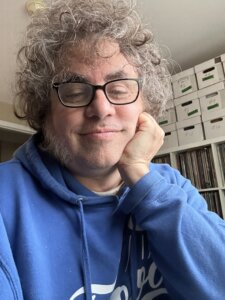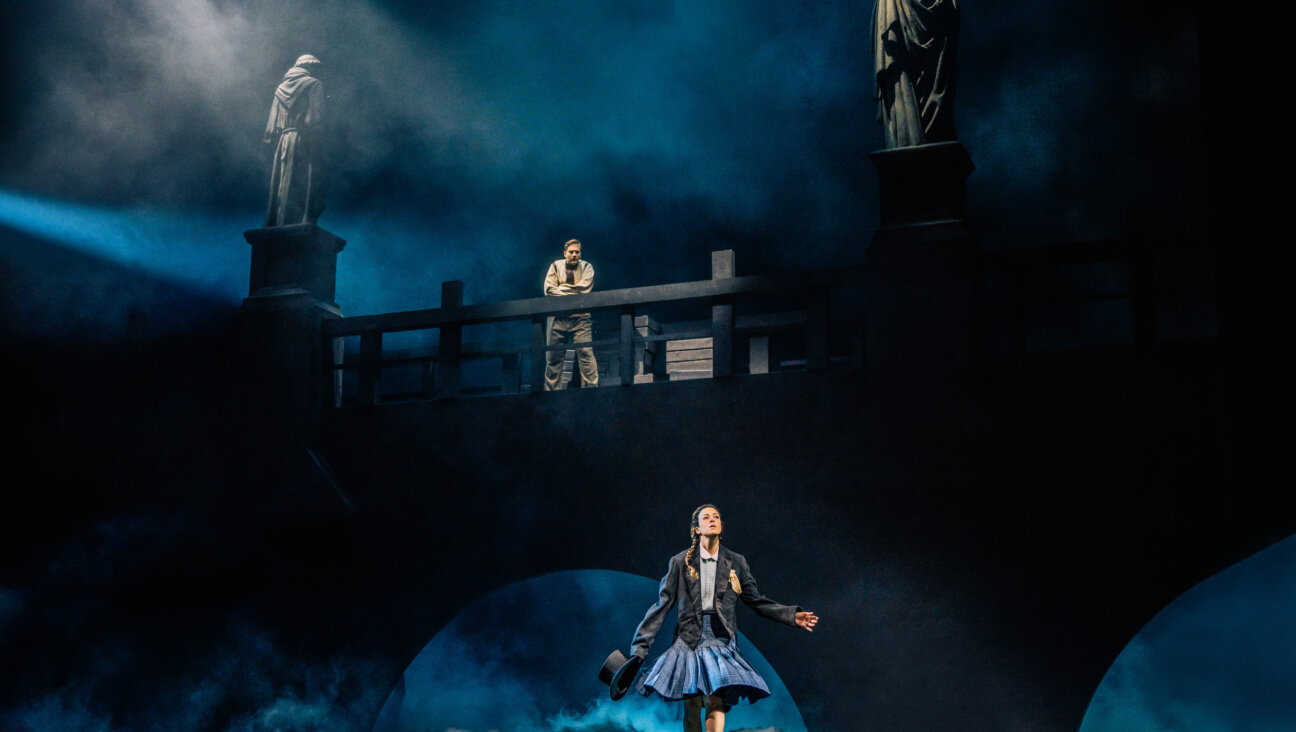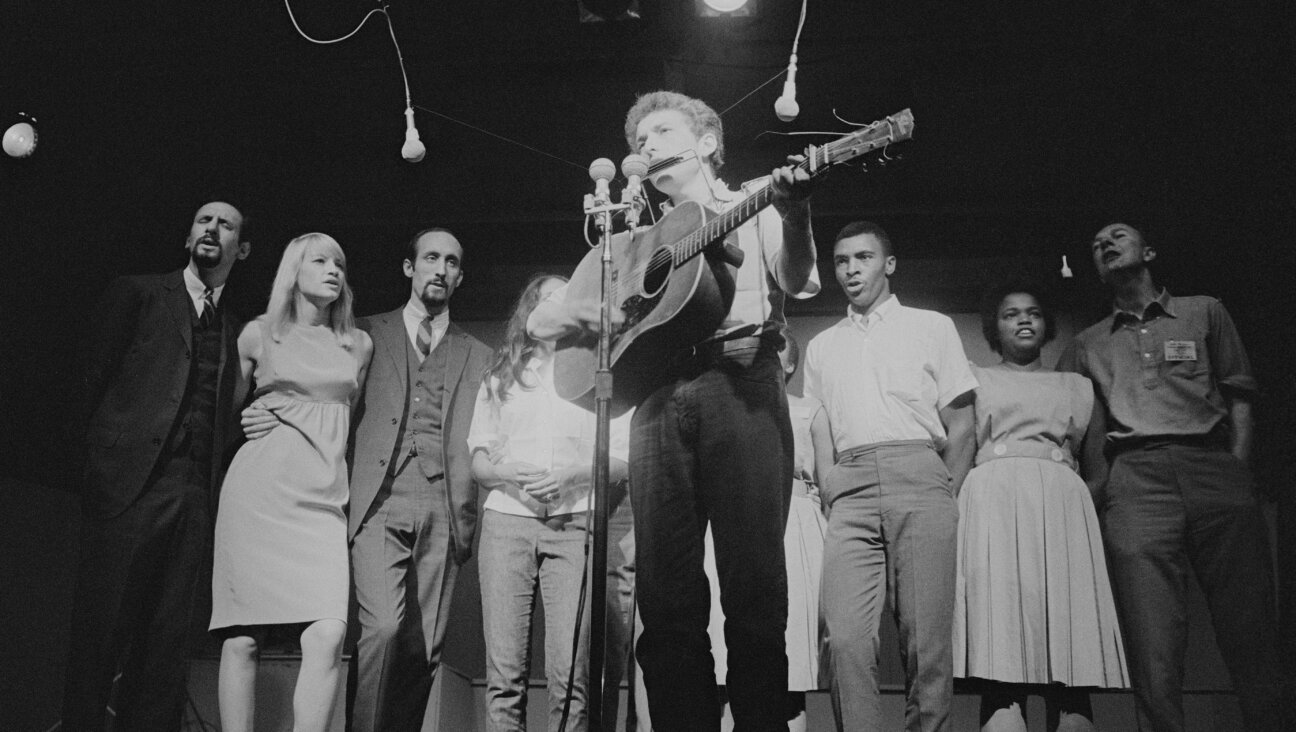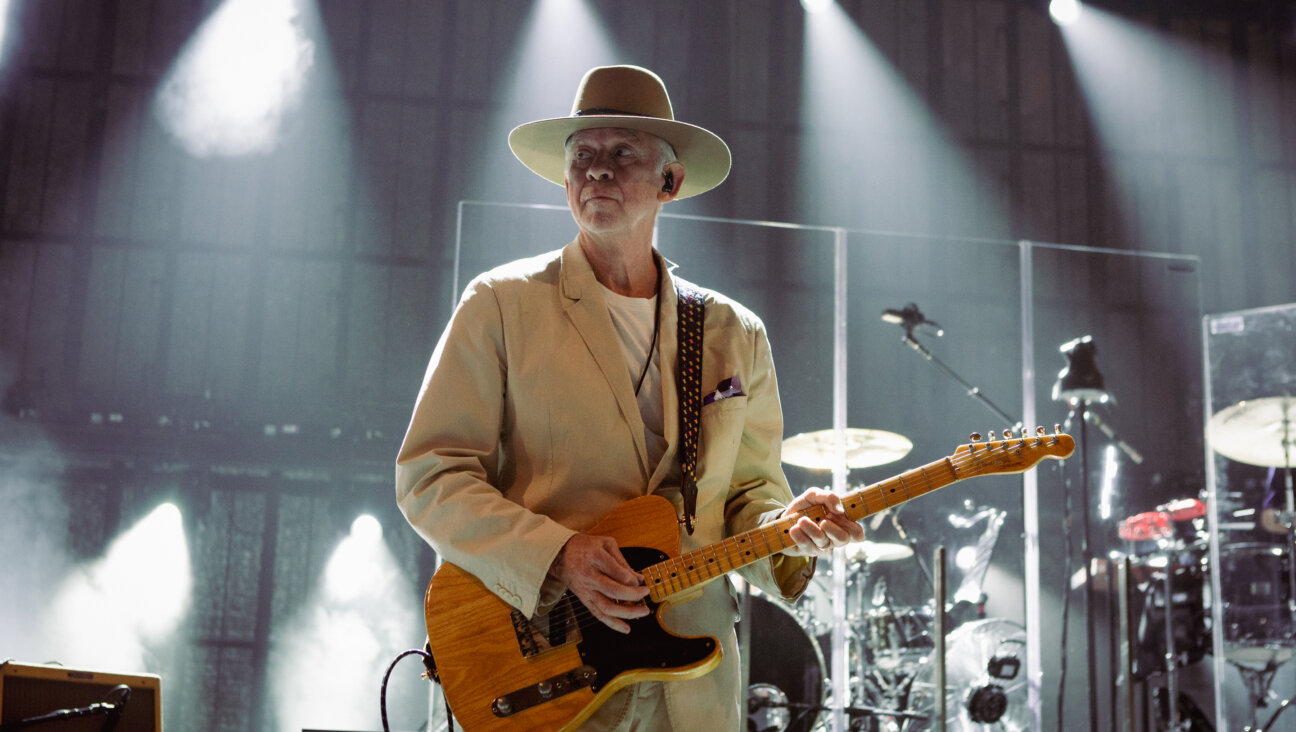Barry Goldberg: Rock ‘N’ Roll’s Most Underrated Jew

Barry Goldberg Image by Courtesy of Bob Merlis
“Jewish soul brother” is a term Barry Goldberg likes to use when praising his favorite musical tribesmen, and it certainly applies to him, as well.
Over the course of his six-decades-and-counting career, the keyboardist, songwriter and producer has had enough musical adventures for three lifetimes, including serving as Bob Dylan’s piano man at the 1965 Newport Folk Festival, where the Mighty Zim controversially “went electric” for the first time in concert, and participating in the cultural watermark that was the 1967 Monterey Pop Festival, when The Electric Flag — the genre-scrambling band he formed with childhood friend Mike Bloomfield and a young drummer named Buddy Miles — made its live debut. He has played keys on countless classic records, including Mitch Ryder and the Detroit Wheels’ “Devil With a Blue Dress On/Good Golly Miss Molly,” the Byrds’ “The Notorious Byrd Brothers,” Leonard Cohen’s “Death of a Ladies’ Man,” the Ramones’ “End of the Century” and the 1968 “Super Session” LP with Bloomfield, Al Kooper and Stephen Stills.
Goldberg has written songs with the legendary Brill Building lyricist Gerry Goffin, including Gladys Knight & the Pips’ 1974 smash “I’ve Got To Use My Imagination,” and he penned “Do You Know How It Feels To Be Lonesome” with cosmic country pioneer Gram Parsons. He co-produced “Blue Night,” a Grammy-nominated (and W.C. Handy award-winning) 1994 album, for Southern soul legend Percy Sledge. He has waxed several acclaimed records in his own right, including an eponymous 1974 album produced by Dylan and by rhythm-and-blues giant Jerry Wexler. And The Rides, his current band with Stills and Kenny Wayne Shepherd, has sent two albums (the 2013 “Can’t Get Enough” and the 2016 “Pierced Arrow”) to the top of the U.S. blues charts.
And yet, even that rundown doesn’t really do Goldberg’s fascinating life sufficient justice. For a fuller picture, check out “Two Jews Blues,” his delightful 2012 memoir with Stephen Roeser, so titled because it revolves around his friendship with Bloomfield), which tells the tale of a Jewish kid who comes from Chicago’s North Side and was enchanted by the jazz and R&B sounds he heard on late-night broadcasts from such black Windy City radio stations as WGES and WVON. The book details how he and Bloomfield became key players in Chicago’s mid-’60s blues scene, in which young, white musicians like Paul Butterfield, Steve Miller and Charlie Musslewhite regularly mingled and jammed with the likes of Muddy Waters and Howlin’ Wolf — but it’s the earliest days of his musical evolution that Goldberg really harkens back to on his new album, “In the Groove.”
Produced by Carla Olson and featuring an impressive array of sidemen, including guitarist James Intveld, saxophonist Joe Sublett and harmonica man Rob Stone, “In the Groove” sees Goldberg playing piano, Wurlitzer and Hammond B-3 organ on such classic 1950s R&B instrumentals like Milt Buckner’s “Mighty Low,” Sil Austin’s “Slow Walk” and Doc Bagby’s “Dumplin’s,” as well as serving up such similarly greasy originals as “The Mighty Mezz” (a tribute to Jewish jazz clarinet-and-sax man Mezz Mezzrow) and “Ghosts in My Basement.” The album’s one noninstrumental track, “Guess I Had Enough of You,” is a fabulously funky anti-Trump missive written by Goldberg with jazz great Les McCann, who also delivers an inspired, scat-inflected vocal performance on the track. “In the Groove” is a stone groove indeed, a lively after-hours party that sounds fantastic at any time of day. Even Goldberg, his own worst critic, admits that he digs it. “It’s actually a record that I really like to listen to myself,” he said, laughing, “and that rarely happens!”
Now living in Los Angeles with his wife, Goldberg graciously took a few minutes out of his busy schedule to boogie down memory lane with the Forward’s Dan Epstein.
Dan Epstein: “In the Groove” is your first solo album in over a decade. Why do an album that’s almost entirely instrumental?
Barry Goldberg: It was just a fun thing for me to do, not with any kind of pretense that it could be a hit, or anything. It was just things that turned me on when I was 12, 13, 14, listening to keyboard stuff on the radio. I just decided that I wanted to do an homage to some of that. “Dumplin’s” by Doc Bagby was one of the first organ instrumentals I knew. “Mighty Low” by Milt Buckner, was the theme song of a radio DJ show I listened to. I always liked Johnny and the Hurricanes, and I loved the B-side, called “Lazy,” which featured the organ. And of course Sil Austin’s “Slow Walk,” which is sort of like a Bill Doggett, “Honky Tonk” sort of thing, so I decided to do “Slow Walk” instead of “Honky Tonk.”
And then you threw in some compositions of your own.
Yes, a few different grooves, a little more contemporary. “In the Groove” is an homage to Marvin Gaye kind of thing. “West Side Girl” is dedicated to my wife, who grew up on the Upper West Side of New York. And I always wanted to do a Jimmy Smith thing, because he was my hero, and that was “The Mighty Mezz.” I never really got to do that on any of the records I played on in the past, so that was a full-on dedication to Jimmy Smith.
How did you get Les McCann for “Guess I Had Enough of You”?
My cousin Rob is an ophthalmologist, and he takes care of Les’s eyes. He knew I was doing a record, and he asked Les, who was more than happy to do something. He’s in a wheelchair now, and doesn’t play the piano anymore, which is a shame — I would love to have heard that magic piano. But he just came to the table as the pro that he was, representing that great period of jazz, which I really loved and respected. So that was an extra added bonus with him in the studio.
It seems like you’ve crossed paths with a pretty large percentage of musical greats from the past 60 years or so.
I’ve been lucky and fortunate, yes. Jerry Lee Lewis was the first one, when I was 19; he came into a club I was playing at in St. Paul, Minnesota; he played my electric piano and I played the organ, and we did “Great Balls of Fire” and “Whole Lotta Shakin’ Goin’ On.” That was the first time of my mind getting blown like that. And then there was Jimi Hendrix, Chuck Berry, Dylan, Neil Young, lots of other really great musicians. And, of course, my present band with Stephen Stills and Kenny Wayne Shepherd. And it’s been wonderful. Sometimes you’re up there on the stage, and you can’t believe you’re feeling the magic. Some of that has to rub off on you, and that’s what’s kept me going.
I love the passage in your book where you’re onstage with Dylan at the Newport Folk Festival: You’re not entirely sure where he’s going, but you’re just kind of rolling with it as he alters the course of popular music as we know it.
It was a surprise, and that’s how greatness happens. You have to have guts, man, if you want to change things. And he changed the course of music in that performance. A lot of people weren’t ready for it, but some were.
Dylan is so often portrayed as this mysterious, almost supernatural figure. But the Dylan in your book comes off pretty much like a regular guy.
Yeah, you know — whenever Michael Bloomfield, Bob and myself were together, it was like three Jewish kids from the Midwest just hanging out and playing together. And that’s pretty much what it was; there was nothing really supernatural about him. Of course, his genius and his talent were that special. But he’s a family guy, and he tries really hard; it’s hard for him, because at that magnitude of stardom, you’re not a private person anymore, and that’s a lot to deal with. But when we were together, we ate together, we hung out together, we fished together, and it was just a really natural thing. And, of course, playing with him was really special.
Your friendship with Michael Bloomfield really seems to have been one of the defining relationships in your life. Music took you both on quite a journey, together and separately.
Yeah, he was my best friend. We met in high school, and all the way through to the end of his life we were best buddies. He introduced me to my wife, and to Dylan, too — not necessarily in that order. [Laughs] He was really important in my life in many ways.
I think he remains an incredibly underrated figure in rock history.
He was underrated, but it really didn’t bother him. He really loved his privacy. He knew how great he was, and he wasn’t intimidated by anyone. He held his own among the greatest. Hendrix, Clapton — he’s right up there.
How did you come to play on the Ramones’ “End of the Century?”
That was a record that Phil Spector called me in to work on. Nobody knew who we were going to play with when we got the call. Jim Keltner and Steve Douglas were the other session guys who were called in to play on that, and we walked into the studio and it was the Ramones! They were a little standoffish at first, because they’d never really played with session guys before. But we were talking, and they found out I was with Mitch Ryder and the Detroit Wheels — “Oh, man, he’s cool!” So that was great. Joey Ramone was a sweetheart, and all the Ramones were really nice to me. It was a really great experience, with Phil producing. I think that was the most commercial album they ever had, and it really took them to another level. They were a great rock-and-roll band, I mean really great!
You’d previously worked with Phil Spector on Leonard Cohen’s “Death of a Ladies’ Man,” correct?
Absolutely, which was a whole other thing to me. And it’s not just because I played on it, but I felt that album was really not understood in this country. It’s more of a European-style record, a Charles Aznavour kind of vibe. Phil put together the music behind Leonard Cohen’s lyrics and whole persona, and I think he really did it justice. Some critics got it, some didn’t, but to me it was a pretty amazing record. And also, Leonard and Phil, personalitywise, did not hit it off so well in the studio. Leonard was not used to a producer — especially a producer like Phil, who was so hands-on. Phil had a concept, and he had to push it through. If you listen to some of the songs on there, like “Death of a Ladies’ Man” and “I Left a Woman Waiting” and “Paper Thin Hotel,” it’s just gorgeous.
Since Spector and Cohen weren’t seeing eye to eye on the project, did you feel caught in the middle?
Me personally? No, not really — I was sort of digging the whole thing! You know, playing with guys like Hal Blaine and Jim Keltner, and being part of that sound, was overwhelming. And Leonard walks in, just impeccably dressed, with two beautiful brunettes, one on each side, and a flask of the best cognac — a real dandy gentleman doing his thing. And just watching that, and watching Phil doing his thing, it was an amazing trip just being there.
It must be difficult to look back and pick out a couple of defining moments or accomplishments from your career. But are there things that make you think, “Yeah, that’s what I’m most proud of?”
Well, obviously, playing with Dylan at Newport, and another was playing with Hendrix for a week [in Greenwich Village, before he became famous]. But the thing that I’m most proud of is the Percy Sledge record that I produced with Saul Davis, called “Blue Night.” I was always into R&B, and the Muscle Shoals thing, and having the opportunity to get into the studio with someone with that beautiful a voice, right up there with Otis Redding as far as a soul singer… I put the musicians together — with Jerry Wexler’s guidance, by the way — and made sure the backgrounds were right for Percy’s voice, just doing the best job I could possibly do for Percy. Because I knew how important it was, working with an artist like that, and that I really had to come through.
Who were some of the musicians you brought in for it?
Steve Cropper came in and played guitar on that record at his own expense, because he wanted to play on a Percy record. He had played with Otis Redding, and he was part of the Stax thing, but he’d never played with Percy. Our guitar section for the record was Bobby Womack, Mick Taylor, Steve Cropper and Greg Leisz, and then Bob Glaub on bass and Ed Greene on drums, and the Waters backgrounds. After we finished it, we sent it to Jerry, and I was really nervous about him hearing it. Wexler wrote back, “F—king masterpiece.” And that was all I needed! You know, you lose a lot of battles and you win a lot of battles, and that was a big one in the winning column.
What was Jerry Wexler like?
He was like my mentor. I know people who did business with him have other things to say, but I never really had to do business with him. I did a lot of sessions for him, and I learned a lot from his technique in the studio, and how he worked. He was a Jewish soul brother to the end, man; he would get in the middle of the studio and do the Funky Broadway, the Jerk and all these dances. You don’t get much cooler than that. He’d get in there with the Southern guys, like, “Hey, man, this is the groove!” And “Midnight Hour,” “Mustang Sally,” all of those songs came out of that. This was the man; this was the godfather of rhythm and blues….
Another great producer I worked with was Bob Crewe. We did a lot of records with him, including three Top 10 records with Mitch Ryder, and that was an amazing experience, too. Working with all these guys, you learn all these techniques and styles of producing. And you learn that sometimes, if you’re producing a great artist, you don’t even have to produce — you let them go.
You wrote songs with Gerry Goffin, including a hit for Glady Knight & the Pips.
That was another dream come true. When I was a kid growing up in Chicago, I would see their names on the back of the records — Goffin-King, Mann and Weil, Ellie Greenwich and Jeff Barry, and I couldn’t have imagined that one day I would be writing with one of those Brill Building people. That was a whole other experience. And not only writing with him, but having success. Gerry was another amazing soul brother, and I really miss him.
What was the writing process like when you worked together?
I would come up with the melody, and he’d write the lyrics. We had a couple of hits, and one of them was “Imagination,” which was originally written for Albert King. We took it to Stax to show it to Albert’s producers, and they rejected it; six months later, Gladys picked it up. And we had another song with Rod Stewart [“It’s Not the Spotlight”]…. When Gerry wrote, he had the magic. Dylan was in awe of Gerry Goffin; I introduced them, and they would play chess together in our building on the Upper West Side of New York. Bob was in awe that Gerry could write such beautiful stories, songs and lyrics in under three minutes — that was Gerry’s art and craft. And Gerry felt in awe of Dylan; Gerry felt unworthy. And I was like, “Come on, man! You’re one of the greatest lyricists of all time!” But Gerry just couldn’t allow himself to have that pleasure, that feeling. And he was, you know? “Up on the Roof,” “Natural Woman” — there was nobody that could touch him.
The Rides have been a cool new chapter for you. What has that experience been like?
It’s really wonderful and exciting playing with them. We’re playing venues that I haven’t played in since the ’60s… Kenny is an amazing blues guitar player, one of the best I’ve ever played with, and Stephen is a superstar. They’re two Southern guys, and I’ve always been really comfortable playing with Southern musicians. We’ve got a great rhythm section, with Chris Layton from Double Trouble on drums, and Kevin McCormick from Crosby, Stills & Nash on bass. It’s a wonderful situation for me, to have this experience with them. There’s no problems; there’s no psychos, no egos, no craziness like the old days. It’s just guys really loving having the chance to play together. And the chemistry is just right; it’s not a “super group,” where you put this one together with that one whether or not it makes sense. We all share the same musical interests. It was a very natural thing.
What’s next for you?
Well, we have an Electric Flag 50th anniversary tour coming up in July in Northern California, and my band the Chicago Blues Reunion, we’re headlining the Calgary Blues Festival in August. Right now, we’re finishing a documentary called “Born in Chicago,” which I’m producing, and we’ve been working on it for 10 years. It’s the story of all the white kids in Chicago, teenagers, learning from the great masters, going down and playing with Muddy and Wolf and all of that. Dan Aykroyd just did the narration, and Bob Sarles, who did a documentary called “Bang: The Bert Berns Story,” which I did the music for, he’s the guy who directed it. So everything is pretty copacetic!

















